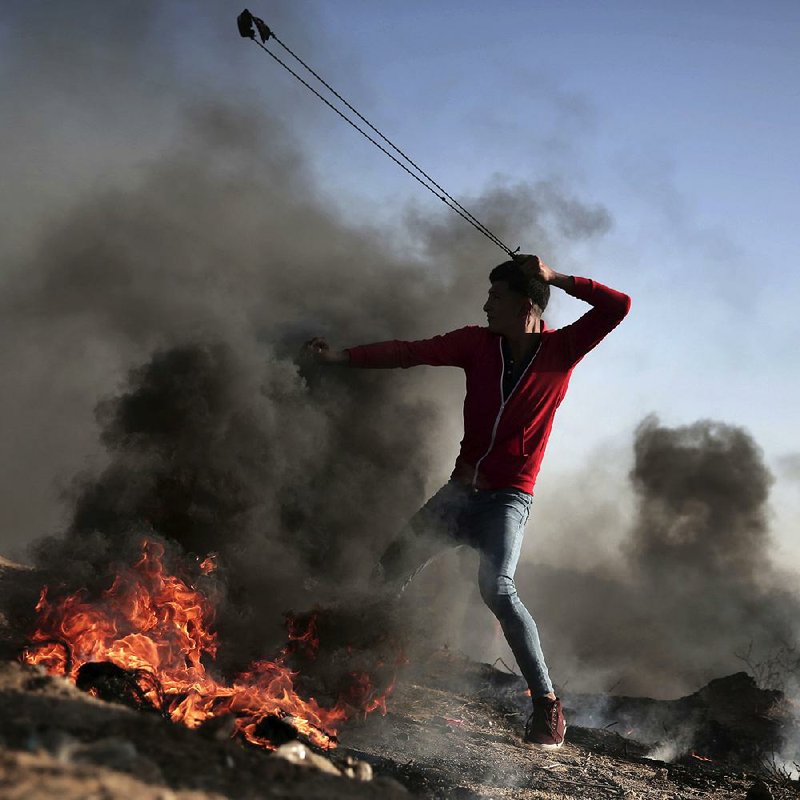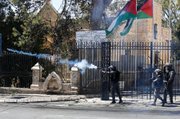GAZA CITY, Gaza Strip -- Israel will target militant groups inside Gaza if violence along the territory's border with Israel drags on, the chief military spokesman warned Saturday, a day after 15 Palestinians were killed by Israeli fire in the area's deadliest violence in four years.
Brig. Gen. Ronen Manelis, Israel's chief military spokesman, said it had so far restricted its actions to the border fence but would go after militants "in other places" if attacks continue.
The violence tailed off significantly Saturday as small groups of Palestinians threw stones in several areas near the border fence, drawing Israeli fire that injured 25 people, the Gaza Health Ministry said.
Some young men broke away Saturday, throwing stones at Israeli soldiers on the other side of the fence, drawing live rounds and tear gas.
In two incidents, an Associated Press reporter saw two men who walked close to the fence get shot in the legs by soldiers.
Friday's mass marches were largely led by Gaza's ruling Hamas group and touted as the start of a six-week-long protest campaign against a stifling decade-old blockade of the territory.
Organizers set up five tent encampments, each several hundred yards from the border, to serve as launch points for protest.
Protests are aiming to culminate in a large border march May 15, the 70th anniversary of Israel's founding. The date is mourned by Palestinians as their "nakba," or catastrophe, when hundreds of thousands were uprooted in the 1948 Mideast war over Israel's creation.
The date has particular resonance in Gaza, where the vast majority of 2 million residents are descendants of refugees. The day, May 15, will this year also coincide with the start of the Muslim holy month of Ramadan.
The opening of the U.S. Embassy in Jerusalem, also set for the anniversary, is expected to add further fuel to protests.
Violence against Israel has surged in recent weeks. Palestinians, who want the eastern part of Jerusalem as their own capital, have been storming the Gaza fence and planting bombs targeting Israeli soldiers, drawing retaliatory fire and airstrikes. At least five Israelis have been killed in stabbing and car-ramming attacks in Jerusalem and the West Bank in recent weeks.
Israeli Prime Minister Benjamin Netanyahu congratulated the soldiers Saturday for allowing the rest of the country to celebrate the Passover holiday safely.
"Israel is acting determinedly and decisively to protect its sovereignty and the security of its citizens," he said.
BLOODY DAY
Palestinian health officials said 15 Palestinians were killed by Israeli fire and more than 750 hit by live rounds Friday, making it the bloodiest day in Gaza since the 2014 cross-border war between Israel and Hamas.
It appears unlikely protests will continue at such a scale, with larger turnouts expected only after Friday noon prayers, the highlight of the Muslim religious week.
Israel's military initially claimed Friday that "thousands of Palestinians are rioting in six locations throughout the Gaza Strip, rolling burning tires and hurling stones." Video released by the army appeared to show fewer actually engaged in direct violence.
On Saturday, Manelis said that while thousands of Palestinians approached the border Friday, those engaged in stone-throwing were in the hundreds.
Manelis denied soldiers used excessive force, saying those killed by Israeli troops were men between the ages of 18 and 30 who were involved in violence and belonged to militant factions. The army later released the names and ages of 10 of the dead, including eight members of Hamas and two from other militant groups.
Manelis alleged Gaza health officials exaggerated the number of wounded, and that several dozen at most were injured by live fire, with others suffering from tear-gas inhalation or other types of injuries. He said soldiers knew who they were shooting at and how many people were hit by live fire.
Four of the 15 dead were members of the Hamas military wing, the group said Saturday. The group said a fifth member who was not on the Health Ministry list was killed near the border, and that Israel has the body. It said another man is also missing in the border area.
The border protests were seen as a new attempt by Hamas to break the border blockade, imposed by Israel and Egypt after the Islamic militant group seized Gaza in 2007 from forces loyal to its rival, Palestinian President Mahmoud Abbas. The continued closure has made it increasingly difficult for Hamas to govern.
Manelis reiterated Saturday that Israel "will not allow a massive breach of the fence into Israeli territory."
He said that Hamas and other Gaza militant groups are using protests as a cover for staging attacks. In a tweet Saturday, the Israeli army called the protest "an organized terrorist operation."
If violence continues, "we will not be able to continue limiting our activity to the fence area and will act against these terror organizations in other places too," he said.
A DEMAND FOR ANSWERS
The family of one young man who was killed, 19-year-old Abdul Fattah Abdul Nabi, is among those demanding an investigation into the Israeli response to the protest, saying videos show he posed no threat.
His family says a video of his death shows the moment Israeli soldiers shot him in the back of the head. The video appears to show Abdul Nabi, dressed in black, running away from the border fence carrying a tire. Just before reaching the crowd, he crumples under gunfire. Although Israel listed a 20-year-old with a similar name among the dead militants, his family said he did not belong to an armed faction.
His family though, made no effort to hide the fact that Abdul Nabi went to demonstrations and threw stones. That's no reason to be shot, they said.
"They were throwing stones, but the stones never even reached the fence," said Alaa Abdul Nabi, 28, a brother of the slain demonstrator. "It's a message, to throw a stone from our land."
Many demonstrators said they were there to protest peacefully. The family of Badr Sabbagh, 20, said he had just arrived to watch the demonstrations when he was shot. They rejected the Israeli army's assertion that everyone killed was involved in violence.
"He asked for a cigarette, I gave it to him, he had two puffs, and then he was shot in the head," said Mohammed Sabbagh, his 29-year-old brother. "He'd only been there 10 minutes."
Israeli human-rights group Adalah and the Gaza-based Al Mezan Center for Human Rights wrote to Israeli Attorney General Avichai Mandelblit to demand accountability.
In the letter, they said the use of such weapons against civilians was a "blatant violation of international laws."
Israel said it stuck to strict rules of engagement to deal with a 30,000-strong crowd along the border, saying "rioters" threw Molotov cocktails and stones, burned tires, and attempted to break through the fence.
The Israeli military did not immediately respond Saturday to requests to clarify the rules of engagement that were followed. In the days preceding the demonstration, it had dropped leaflets warning residents in Gaza to stay at least 328 yards from the border fence or risk being shot.
In response to the video of Abdul Fattah Abdul Nabi's killing, the Israeli military warned that Hamas had published several videos of Friday's events, "some of which only depict parts of incidents while others are edited or completely fabricated."
Two other videos were circulated online that showed the shooting from different angles, while witnesses said Abdul Nabi was clearly running away from the fence.
Palestinian photographer Mahmoud Abu Salama was taking photos at the time, capturing Abdul Nabi's last moments. He said the man in the video wearing the green shirt had run toward the border fence to pick up a tire left there earlier in the morning. He is seen in the video belly-crawling toward the tire before picking it up and running back to the crowd as bullets kick up dust around his feet. As he stumbles, Abdul Nabi runs to help him and grabs the tire.
He was shot from behind a few hundred yards away from the fence, Salama said.
"He was killed in cold blood," Alaa Abdul Nabi said. "We will report that to the United Nations. We want to know who participated in killing him. He wasn't armed."
But he had little hope anyone would be held accountable, a sentiment echoed by Israeli human-rights group B'Tselem.
"These are the predictable outcomes of a manifestly illegal command: Israeli soldiers shooting live ammunition at unarmed Palestinian protesters," said Amit Gilutz, a spokesman for the group. "What is predictable, too, is that no one -- from the snipers on the ground to top officials whose policies have turned Gaza into a giant prison -- is likely to be ever held accountable."
Information for this article was contributed by Fares Akram, Aron Heller and Karin Laub of The Associated Press; by Loveday Morris and Hazem Balousha of The Washington Post; and by Jonathan Ferziger, Saud Abu Ramadan, Michael S. Arnold and Yaacov Benmeleh of Bloomberg News.
A Section on 04/01/2018


